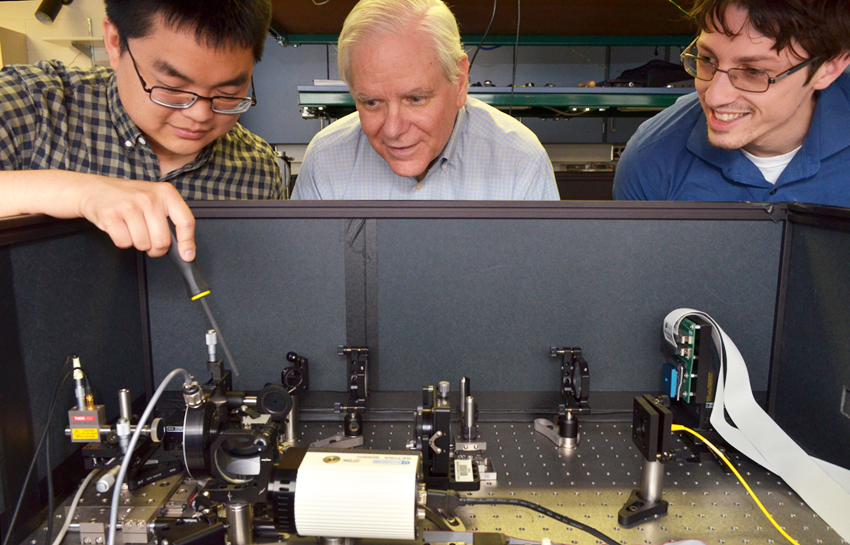2019 Hajim School Lifetime Achievement Award: James Fienup
August 27, 2019

In addition to remarkable research and teaching skills, this year’s recipient of the Hajim School Lifetime Achievement Award has a splendid knack for reading the writing on the wall. (Presented September 9, 2019 by Wendi Heinzelman, Dean of the Hajim School of Engineering and Applied Sciences)
For example, he attended Stanford University intending to get a PhD in solid state theory, until a student who had just completed the same degree lamented that he had not received a single response to 250 resumes he sent out. Not even an interview.
Not wanting to find himself in the same predicament, our recipient switched to optics.
Later, he had a dream position as a scientist with a nonprofit research institute where he was able to pretty much set his own agenda. Then it was bought by investors determined to sell it off to a large company. Our recipient again read the writing on the wall—others would soon be setting the agenda, not him.
After much coaxing, he joined the Institute of Optics in 2002—and we have been benefiting from that decision ever since.
Jim Fienup’s career “exemplifies the best we expect of faculty,” says Scott Carney, director of the institute “Rarely is a member of the faculty able to so excel in teaching, research, leadership, and service” in the way Jim has.
The first thing you need to know about Jim Fienup is that he is one of the world’s leading experts in phase retrieval—his paper “Phase Retrieval Algorithms: a Comparison,” is the most highly cited paper (out of over 50,000) in the journal Applied Optics.
He has also helped pioneer wave front sensing and control.
So why is this important?
Remember the scene from the movie Apollo 13, when the astronauts are getting bounced and jiggled during the launch at Cape Canaveral?
Imagine what all that bouncing does to a finely tuned space telescope when it is launched into orbit.
Jim Fienup is the expert that NASA turns to when the panels of those telescopes need to be realigned and synchronized to incredibly precise tolerances once they are in orbit.
The phase retrieval algorithms he and his team developed helped fix the Hubble Space Telescope's infamous nearsightedness when it was first launched in 1990.
Since 2004 he’s served as a member of the Product Integrity Team for NASAs James Webb Space Telescope. which will need phase retrieval to align the 18 segments of the primary mirror. And at least two other telescope projects will benefit.
“Dr. Fienup is an amazing leader in his field, but not only that, he continues to inspire others to learn, contribute, and develop the technologies that are essential to our space program,” says Bruce H. Dean, Wavefront Sensing Group Leader at NASA’s Goddard Space Flight Center. “His research program has tackled many problems in wavefront sensing that were once believed to be intractable... but through his research, we now have elegant solutions to these problems, which in turn will be utilized on-board the James Webb Space Telescope.”
Joseph Goodman, Jim’s mentor at Stanford, says of the 49 talented PhD students he’s supervised, including the current Chancellor of the SUNY system and the former Director of the Johnson Space Center, Jim has turned out to be the best scientist/engineer. And not only for his phase retrieval work.
“I am privy to some of the details of Jim’s classes in the areas of Fourier Optics and Statistical Optics. His attention to detail, his perspective on problems in these areas, the elegance of his solutions to outstanding problems, all place him at the pinnacle of his field,” Professor Goodman says. “Many of his students have become leaders in their respective fields.”
One of those students, Samuel Thurman, a former postdoc now with Lockheed Martin, says he continues to benefit from Jim’s mentoring during that formative stage of his career. “Jim has a boundless childlike curiosity, which often is exhibited by seemingly endless inquisitions about scientific concepts. I still look to him as proof that I do not need to abandon my sense of natural wonder in order to have a successful career.”
From Jim he learned to:
- Pay closer attention to ensuring his technical work was correct down to the finest detail.
- Participate in communal service, not just to one’s professional society or students, but the greater worldwide community.
- Take time out from theory and experiments to spend time with the people around him.
“I first learned to play the sport of disc golf on an outing with Jim’s research group,” Thurman relates. “It was times like this that solidified my friendship with Jim and his lasting impact on me. I recently bought a set of discs and began playing with my children. The next time I meet Jim at a conference, I will be ready to challenge him to round.”
Finally, Gerard Rafanelli, senior engineering fellow at Raytheon, describes Jim is “one of the most scientifically honest and ethical individuals I know. He is always willing to tell the scientific and engineering truth, even if it is an undesirable outcome for his sponsors.”
No wonder Professor Goodman says: “The University of Rochester is lucky to have Jim on its faculty,”
And don’t we know it! That’s why I am proud to present Jim with the Hajim School lifetime achievement award.
